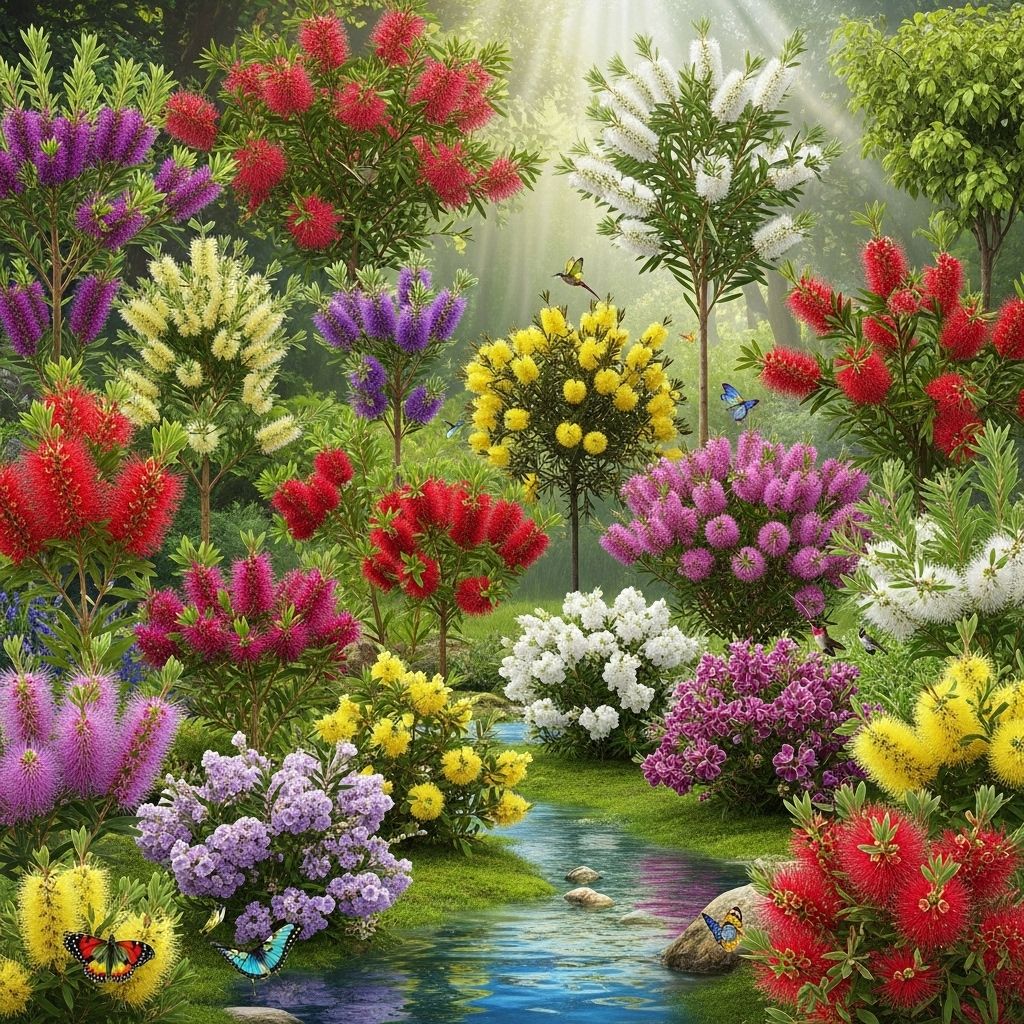27 Stunning Bottlebrush Varieties for Your Garden
Scented foliage and brushlike flowers invite pollinators and add color all year round.

Image: HearthJunction Design Team
Introduction to Bottlebrush Varieties
Bottlebrush plants, known for their flamboyant flower spikes and aromatic foliage, are evergreen wonders that bring vibrant splashes of color to any garden. Native to Australia, these attractive plants have gained popularity worldwide—especially in tropical and subtropical regions. Whether grown as compact shrubs or substantial trees, bottlebrush varieties enchant gardeners with their showy blooms and resilience in diverse landscapes.
Why Grow Bottlebrush in Your Garden?
- Versatile Growth Habits: Suitable for hedges, screenings, accent specimens, or even bonsai.
- Attractive Foliage: Many varieties offer aromatic leaves and unique foliage shapes.
- Vivid Flower Colors: Range from fiery reds and pinks to whites and yellows.
- Wildlife-Friendly: Their nectar-rich flowers attract pollinators such as bees, butterflies, and hummingbirds.
- Low Maintenance: Generally easy to care for, drought-tolerant, and deer-resistant.
Understanding Bottlebrush Types
The bottlebrush group is botanically classified primarily under the genera Callistemon and Melaleuca. While names can be confusing due to taxonomic revisions, most gardeners use Callistemon for the classic bottlebrushes, with Melaleuca encompassing closely related species.
27 Top Bottlebrush Varieties for Gardens
Here is a detailed overview of popular and distinctive bottlebrush plants that can transform any landscape:
1. Crimson Bottlebrush (Callistemon citrinus)
- Height: 3–25 feet
- Flower: Bright red, brush-like spikes
- Foliage: Lemon-scented when crushed
- Use: Excellent hedge or accent shrub; deer- and drought-resistant
2. Weeping Bottlebrush (Callistemon viminalis)
- Height: 20–30 feet
- Flower: Scarlet-red, gracefully drooping spikes
- Foliage: Cascading, willow-like
- Use: Ornamental tree, especially near water features; deer- and drought-tolerant
3. Stiff Bottlebrush (Callistemon rigidus)
- Height: 10–20 feet
- Flower: Dense red clusters
- Foliage: Dark green, tough leaves
- Use: Low-maintenance hedging; pest-resistant
4. Prickly Bottlebrush (Callistemon brachyandrus)
- Height: Up to 10 feet
- Flower: Scarlet spikes with yellow pollen
- Foliage: Sharp-tipped, pointy leaves
- Use: Natural fencing; wear gloves when pruning
5. White Bottlebrush (Callistemon salignus)
- Height: Up to 25 feet
- Flower: Creamy-white, fluffy spikes
- Foliage: Willow-like, glossy
- Use: Elegant screens or hedges
6. Cliff Bottlebrush (Melaleuca comboynensis / Callistemon comboynensis)
- Height: 5–10 feet
- Flower: Classic bottlebrush spikes (red or pink)
- Foliage: Narrow, coppery young leaves, maturing to jade
- Use: Bonsai, container plant, or specimen shrub
7. Little John Bottlebrush (Callistemon citrinus ‘Little John’)
- Height: 3–5 feet
- Flower: Deep red to burgundy
- Foliage: Compact and dense
- Use: Borders, container planting, foundation shrubs
8. King’s Park Special (Callistemon viminalis ‘King’s Park Special’)
- Height: Up to 15 feet
- Flower: Vibrant red
- Use: Mass plantings, feature trees
9. Western Glory Bottlebrush (Callistemon viminalis ‘Western Glory’)
- Height: 6–8 feet
- Flower: Bright red
- Use: Medium-sized hedges or specimen plants
10. Red Cascade Bottlebrush (Callistemon viminalis ‘Red Cascade’)
- Height: 6–8 feet
- Flower: Rich red, arching spikes
- Use: Eye-catching focal point in smaller gardens
11. Hannah Ray Bottlebrush (Callistemon viminalis ‘Hannah Ray’)
- Height: 10–15 feet
- Flower: Large, pendulous, deep red
- Use: Dramatic accent tree
12. Dwarf Bottlebrush (Callistemon subulatus ‘Brogo Overflow’)
- Height: 2–4 feet
- Flower: Crimson
- Use: Low borders, ground cover, small spaces
13. Mauve Mist Bottlebrush (Callistemon ‘Mauve Mist’)
- Flower: Mauve to pale purple spikes
- Use: Unique color for mixed borders
14. Pink Champagne Bottlebrush (Callistemon ‘Pink Champagne’)
- Flower: Soft, pastel pink
- Use: Romantic gardens, color contrast
15. Hot Pink Bottlebrush (Callistemon ‘Hot Pink’)
- Flower: Vivid hot pink spikes
- Use: Bold statement in borders
16. Burgundy Bottlebrush (Callistemon ‘Burgundy’)
- Flower: Deep burgundy to purple
- Use: Dramatic color in mixed shrub plantings
17. Endeavour Bottlebrush (Callistemon citrinus ‘Endeavour’)
- Flower: Large, bright red spikes
- Use: Main focal plant
18. Perth Pink Bottlebrush (Callistemon phoeniceus ‘Perth Pink’)
- Flower: Clear pink
- Use: Subtle color in mixed borders
19. Great Balls of Fire (Callistemon ‘Great Balls of Fire’)
- Foliage: Bright, coppery new growth
- Use: Hedge with foliage interest year-round
20. Scarlet Flame Bottlebrush (Callistemon ‘Scarlet Flame’)
- Flower: Intense scarlet red
- Use: Accent for vibrant gardens
21. Purple Splendour Bottlebrush (Callistemon ‘Purple Splendour’)
- Flower: Deep purple spikes
- Use: Rare coloring for collectors
22. Slim Bottlebrush (Callistemon ‘Slim’)
- Shape: Narrow, upright habit
- Use: Tight spaces, screening, or narrow borders
23. Green Bottlebrush (Callistemon viridiflorus)
- Flower: Lime-green bottlebrushes
- Use: Unique color for mixed gardens
24. Lemon Bottlebrush (Callistemon pallidus)
- Flower: Creamy-yellow spikes
- Use: Soft, pastel landscape themes
25. Willow Bottlebrush (Callistemon salignus)
- Flower: White to creamy-pink spikes
- Foliage: Slender, willow-like leaves
- Use: Elegant hedging or specimen
26. Alpine Bottlebrush (Callistemon pityoides)
- Flower: Lemon-yellow
- Use: Cooler regions, rockeries, and alpine gardens
27. Mallee Bottlebrush (Callistemon brachyandrus)
- Flower: Red, with yellow-tipped stamens
- Use: Dry, warm climates; naturalistic landscapes
Bottlebrush Care and Growing Tips
- Climate: Thrive in USDA hardiness zones 8-11. Most bottlebrush plants prefer warm, frost-free conditions, though some alpine species tolerate cool.
- Light: Full sun yields the best flowering.
- Soil: Well-drained, slightly acidic to neutral. They are adaptable but dislike heavy, soggy soils.
- Water: Once established, most are quite drought-tolerant. Young plants need regular watering until root systems mature.
- Pruning: Light pruning after flowering encourages bushier growth and more flowers the following season. Remove spent blooms and dead branches.
- Fertilizer: Use a balanced, low-phosphorus fertilizer in spring for best results.
Common Uses for Bottlebrush Varieties
- Hedges and Screens: Stiff and upright varieties create dense privacy screens.
- Specimen Trees and Shrubs: Weeping and large-flowered types make dramatic focal points.
- Containers and Small Spaces: Dwarf selections like ‘Little John’ are ideal.
- Wildlife Gardens: All bottlebrushes support pollinators and birds.
- Coastal Landscapes: Many varieties tolerate wind and salt spray.
Comparison Table of Select Bottlebrush Varieties
| Variety | Botanical Name | Height (ft) | Flower Color | Sun | Special Use |
|---|---|---|---|---|---|
| Crimson Bottlebrush | Callistemon citrinus | 3–25 | Red | Full Sun | Hedge, Specimen |
| Weeping Bottlebrush | Callistemon viminalis | 20–30 | Red | Full Sun | Ornamental Tree |
| White Bottlebrush | Callistemon salignus | Up to 25 | White | Full Sun | Screen, Hedge |
| Little John | Callistemon citrinus ‘Little John’ | 3–5 | Burgundy | Full Sun | Containers |
| Cliff Bottlebrush | Melaleuca comboynensis | 5–10 | Red/Pink | Full Sun | Bonsai, Shrub |
Frequently Asked Questions (FAQs)
Q: What is the best soil for bottlebrush plants?
A: Bottlebrushes thrive in well-drained, slightly acidic to neutral soils. Avoid heavy clay or waterlogged conditions; if your soil is heavy, amend with compost or plant on a mound.
Q: Do bottlebrush plants attract wildlife?
A: Yes, their nectar-rich flowers are highly attractive to bees, butterflies, and hummingbirds, making them excellent for supporting local biodiversity.
Q: When should I prune my bottlebrush?
A: Prune lightly after flowering to shape the shrub and encourage bushy growth. Avoid heavy pruning into old wood as recovery can be slow.
Q: Are bottlebrush varieties frost-tolerant?
A: Most are not frost-hardy and should be grown in warm, frost-free regions. However, some alpine species (like Callistemon pityoides) can handle brief cold spells.
Q: Can bottlebrushes be grown in containers?
A: Yes, compact varieties such as ‘Little John’ and dwarf types do well in containers, provided they receive full sun and well-drained potting mix.
Conclusion: Choosing Your Perfect Bottlebrush
Whether you’re searching for a show-stopping tree for your front yard, a low-maintenance hedge, or a pollinator-attracting accent for your landscape, there’s a bottlebrush variety to suit every garden style. With dazzling colors, aromatic foliage, and robust adaptability, these evergreens are among the most rewarding plants for gardeners seeking year-round interest and easy care.
References
Top Bottlebrush Varieties Guide: Best Shrubs for Color
Watch now to discover top bottlebrush varieties and expert planting tips for stunning, low-maintenance blooms. Learn ideal site, soil, and pruning advice to grow vibrant shrubs in your garden.
Read full bio of Shinta












